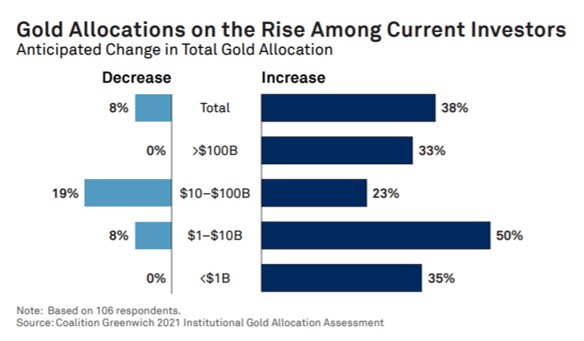Alt Investments
Gold's Back On Agenda As Inflation Worries Grow - Study

Gold may not have the tech "cool" of cryptocurrencies such as bitcoin at the moment but it's been a store of value over the centuries. As inflation clouds gather, so are asset allocators looking at the yellow metal.
Concerns about inflation as governments’ massive central bank
money printing efforts, coupled with dislocations caused by the
pandemic, are encouraging institutional investors to hold the
classic hedging tool of gold, so figures show.
A survey of 477 institutional investors around the world showed
that demand for inflation-hedging tools is helping to drive
allocations to gold, a report published by the World Gold
Council, the body representing mining, trading and investment
organisations, said. The report was compiled by the research
group, Coalition Greenwich, between October 2020 and January this
year.
Recent inflation numbers have started to stoke concerns that the
sheer amount of central bank quantitative easing – as banks have
bought up government debt – is starting to make an impact.
Dislocations to some global supply chains is also held to be a
factor. In the US, for example, the consumer prices index rose at
an annual rate of 5 per cent in May, up from 4.2 per cent in
April and the highest since August 2008. For investors used to
tame consumer price numbers for the past decade, the figures are
a jolt.
Gold has in some ways taken a back seat to cryptocurrencies in
recent years as a talking point about how to protect against
inflation and government policy shifts, but gold remains an
important asset class and central bank reserves asset. The third
iteration of “Basel” rules, which set risk capital weights banks
must use, has the effect of classing physical gold – as possible
to proxies such as gold certificates or ETFs – as a zero-risk
asset. Banks holding gold proxies must set aside more reserves.
New rules came in at the end of June.
Investors around the world are responding to signs of rising
prices, injecting new volatility into global financial markets.
"For the most part, however, Western policymakers view recent
price hikes as temporary effects of an economy emerging from a
pandemic-induced slumber,” the Coalition Greenwhich report
said.
“Largely unfazed by the inflation threat, the US Federal Reserve
appears committed to maintaining both its asset purchase
programme and its low-interest-rate policy, and the Biden
administration continues to support stimulus and spending
packages that together would inject trillions of additional
dollars into a US economy that some fear is already
overheating.”
Some 45 per cent of study respondents include interest-rate
projections as one of the top three drivers of long-term
portfolio allocations. For short-term allocations, half of
institutions cite liquidity concerns as a top-three driver, and
around 40 per cent cited interest-rate projections, reflecting
concerns about both near-term market conditions and the threat of
inflation, it said.
About one in five institutions have specific allocations to gold
in their portfolios. Allocations are most common among
institutions in Europe, the Middle East and Africa (29 per cent)
and among the world’s biggest institutions, or those with more
than $10 billion in assets (27 per cent). The average gold
allocation for investors who own or include gold in their policy
portfolio was 4 per cent. Almost 40 per cent of current gold
investors expect to increase their allocations in the next three
years, and about 40 per cent of institutional investors who do
not have gold exposure but have a target or have considered it,
plan to make an investment in that time frame, it said.

